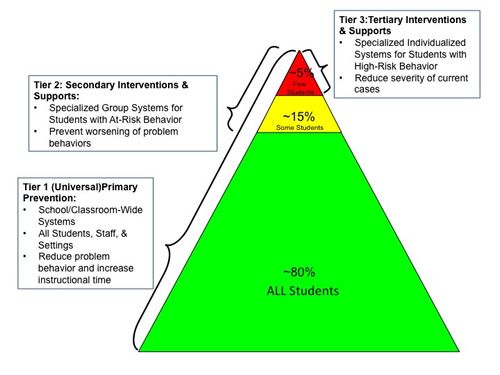
PBIS offers three tiers of behavioral supports to students. In the first tier, behavioral expectations are established and taught to all students. In the second tier, students needing additional support are offered group level interventions. Students needing significant support for behavioral challenges are provided evidence-based interventions tailored specifically to their needs in the third tier.

Tier 1 supports are intended for all students in the school. The core components of prevention include setting clear behavioral expectations, creating an acknowledgment system to reinforce desired behaviors, and developing a system for addressing misbehavior. A PBIS school will have a Universal Building Team that guides the school in implementing PBIS to fidelity.
Creating clear expectations is the first step in developing a school-wide PBIS program. The Universal System consists of rules, routines, and physical arrangements that are developed and taught by school staff to prevent problem behavior. Research indicates that 3-5 behavioral expectations that are positively stated, easy to remember, and significant to the individual school are best. A visitor should be able to walk into the school and ask ten random students to name their school’s behavioral expectations and at least 80% of the students should be able to state what they are and give examples of what they look like in action.
A school-wide matrix lists the general behavioral expectations and specific expectations for various settings within the school. The settings chosen for the matrix are areas where the behaviors can be taught, modeled, practiced, and observed. The matrix provides a clear visual of all school-wide behavioral rules/expectations.
It is necessary to teach the school-wide expected behaviors to all students. Practices include:
Primary Prevention is effective for at least 80% of all students in a given school (based upon criterion of the number of students who have one or fewer office discipline referrals per month). But obviously, no intervention works across the board for all students. For a variety of reasons, some students do not respond to the kinds of efforts that make up Primary Prevention, just as some children do not respond to initial teaching of academic subjects. Some children need additional support to encourage positive behaviors.
One of the core components of PBIS is data-based decision-making. There are various data tools used to assess and evaluate the effectiveness of Primary Prevention. The tools used include School-Wide Information Systems (SWIS) and various PBIS Assessments. The Universal Building Team uses a data system to measure the effectiveness of the primary supports in the building.
SWIS: School-Wide Information Systems – The School-Wide Information Systems (SWIS) data program has been adopted by the Sheboygan Area School District as the tool for collecting data. All information from discipline referrals is entered into the SWIS program. With this information in the system, the Universal Building Team can easily access the “Big Five” data sources. The “Big Five” include:
This information is used to analyze the Primary Prevention systems and evaluate whether or not they are working (80% of students should be responding to the Universal Tier) to help guide school-wide initiatives and action plans, to identify students in need of Tier 2 Interventions and Supports. The “Big Five” data and decisions related to data are shared at staff meetings on a monthly basis.
For details about how Tier 1 (Universal) Primary Prevention looks in each implementing school, refer to the PBIS link for the school.